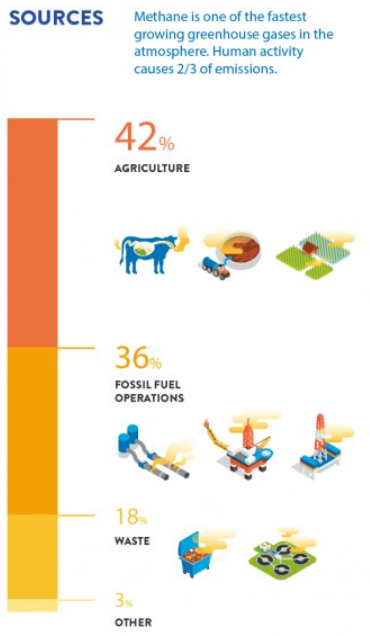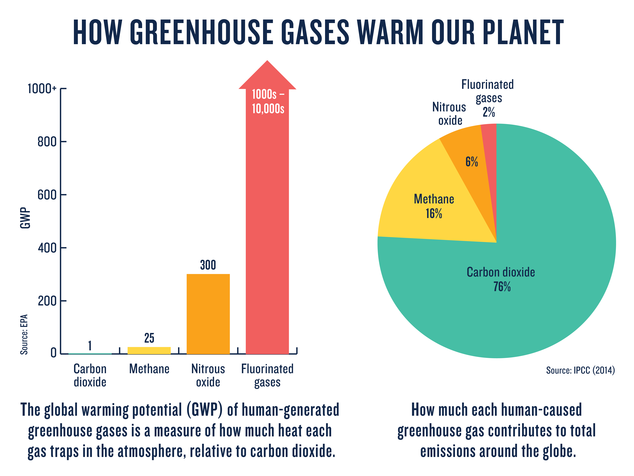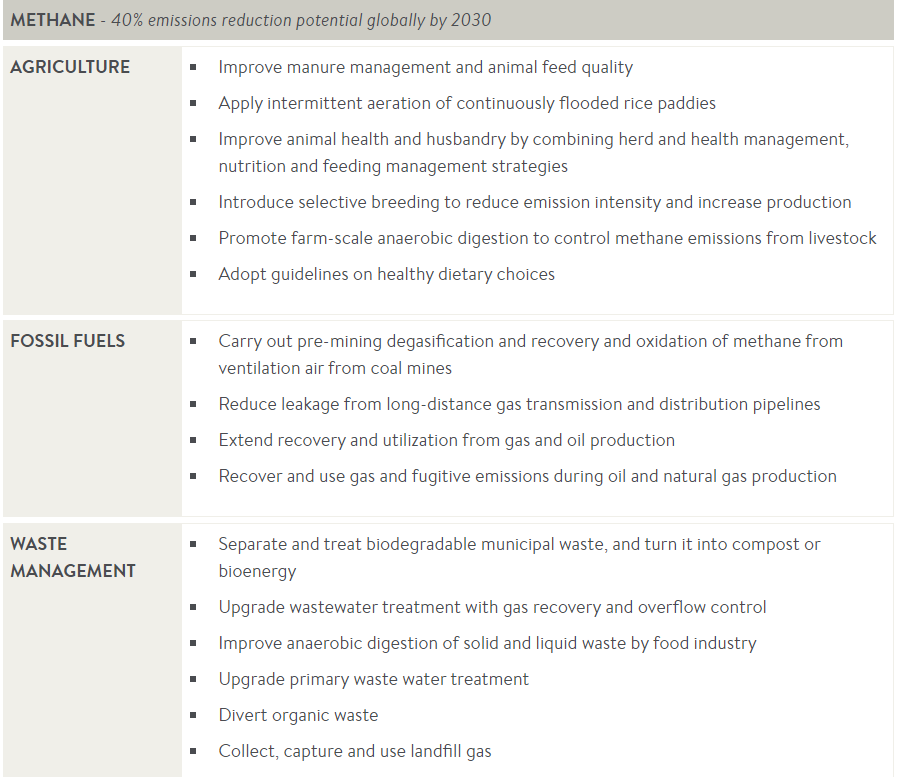Reducing Methane Emission
2021 NOV 30
Mains >
Environment & Ecology > Global warming > Climate treaties and protocols
IN NEWS:
- At the recently concluded COP26 in Glasgow, at least 90 countries have signed the Global Methane Pledge, but India and China abstained from it.
METHANE:
- Methane (CH4) is a hydrocarbon and is a primary component of natural gas.

- Methane is emitted from a variety of anthropogenic and natural sources:
- Natural emission sources include wetlands and decay of organic waste.
- Anthropogenic emission sources include landfills, oil and natural gas systems, coal mining, agricultural activities, commercial livestock rearing, wastewater treatment, and certain industrial processes.
WHY REDUCE METHANE?
- Greenhouse gas:
- Methane is the second most abundant anthropogenic GHG after carbon dioxide (CO2), accounting for about 20 percent of global emissions.

- Higher global warming potential:
- Methane has more than 80 times the warming power of CO2 over the first 20 years after it reaches the atmosphere. Even though CO2 has a longer-lasting effect, methane sets the pace for warming in the near term.
- Increasing emission levels:
- Methane has accounted for roughly 30 per cent of global warming since pre-industrial times and is proliferating fast. In the last two centuries, methane concentrations in the atmosphere have more than doubled, mainly due to human-related activities.
- Health concerns:
- Methane is the primary contributor to the formation of ground-level ozone, a hazardous air pollutant and greenhouse gas, exposure to which causes 1 million premature deaths every year.
- To attain the 1.5 °C target:
- Carbon dioxide remains in the atmosphere for hundreds of years. So, even if emissions were immediately and dramatically reduced, it would not have an effect on the climate until later in the century.
- But it takes only about a decade for methane to break down. So, reducing methane emissions now would have an impact in the near term and is critical for helping keep the world on a path to 1.5°C.

|
Global Methane Pledge:
- The pledge was first announced in September by the US and EU. At least 90 countries have signed the Global Methane Pledge.
- One of the central aims of this agreement is to cut down methane emissions by up to 30 per cent from 2020 levels by the year 2030.
- https://www.ilearncana.com/details/Global-Methane-Pledge/2648
|
INDIA AND METHANE EMISSION:
- India is the third largest emitter of methane, primarily because of the size of its rural economy and by virtue of having the largest cattle population.
- In a communication to the United Nations Framework Convention on Climate Change, India said approximately 20% of its anthropogenic methane emissions come from agriculture (manure management), coal mines, municipal solid waste, and natural gas and oil systems.
- To tap the potential of methane as a source of energy, the Ministry of New and Renewable Energy (MNRE) is investing heavily in a national strategy to increase biogas production and reduce methane emissions.
- Some of the key initiatives to reduce methane emission include:
- Waste-to-Energy:
- The projects focus on converting urban wastes, including municipal solid waste, industrial waste/effluent, and agricultural waste, into fuel in the form of biogas.
- New National Biogas and Organic Manure Programme:
- The NNBOMP promotes the use of biogas produced from cattle manure and other organic wastes available in rural areas. The programme has helped establish multiple small-scale and community-scale biogas plants.
- Galvanising Organic Bio-Agro Resources Dhan (GOBAR-Dhan)
- The GOBAR-Dhan initiative aims to improve sanitation in Indian villages by funding projects that process livestock manure and agricultural waste to produce biogas.
- Sustainable Alternative Towards Affordable Transportation (SATAT)
- SATAT is an initiative aimed at setting up of Compressed Bio-Gas production plants (CBG) and make it available in the market for use in automotive fuels.
- SATAT envisages establishing 5000 CBG plants across the country by 2023.
CHALLENGES IN TACKLING METHANE EMISSION:
- Food security concerns:
- Paddy rice cultivation and livestock are the two major sources of methane emission. To cut down emissions would mean stringent control on these activities, which can affect the food security of developing countries like India.
- Technological barrier:
- Developing countries are not familiar with the technologies available for methane recovery or the potential for profitable recovery projects. Hence, large volumes of methane generated from wastes is left unutilised.
- Limited incentives for private sector:
- A weak energy market and limited policy support means countries have largely failed to provide the private sector with a climate to invest in projects to capture and utilize methane.
- Lack of climate finance:
- Despite repeated promises as UNFCCC CoPs, developed countries have failed to provide the finance necessary for adoption of clean technology, decarbonisation or resource efficiency.
WAY FORWARD:
- Adopt new agricultural practices:
- For paddy rice cultivation, experts recommend alternate wetting and drying approaches. Here, paddies could be irrigated and drained two to three times throughout the growing season, thereby limiting methane production without impacting yield. That process would also require one-third less water, making it more economical.
- Revitalise livestock rearing:
- The animal husbandry industry should be supported to enhance the nutritional quality of feed, so that emissions from gastroenteric releases reduces. Also, manure management should be made a commercially profitable activity through the development of biogas plants.
- Collaborate with major emitters:
- The oil and gas industry should be encouraged to minimize methane losses. For the same, production linked subsidies and other incentives may be provided.
- In other sectors, the operators of landfills, coal mines and wastewater-treatment plants should be incentivised to capture the gas and use it to generate electricity.
- Capacity building:
- Improved access to information and technical training would be beneficial to generating support for methane recovery projects. To create the same, strong incentivisation and academia-industry collaboration should be developed.
- Sector specific initiatives:

PRACTICE QUESTION:
Q. Reducing methane emissions is critical for helping keep the world on a path to 1.5°C. In this regard, discuss the various measures taken by India towards reducing methane emission?



